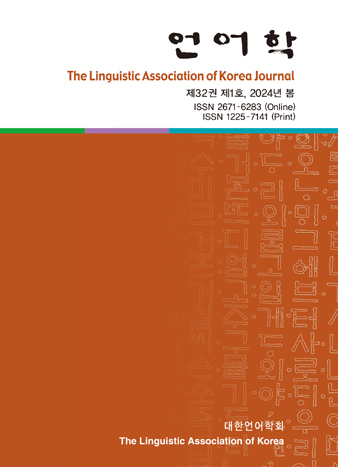대한언어학회 전자저널

32권 1호 (2024년 3월)
- Beyond In-Situ: Exploring Movement in Why-stripping
-
Hyosik Kim
Pages : 113-126
Abstract
Kim, Hyosik. (2024). Beyond in-situ: Exploring movement in why-stripping. The Linguistic Association of Korea Journal, 32(1), 113-126. This paper is concerned with the structure of why-stripping constructions in Korean and English. Two competing analyses have been proposed in the literature: the focus-movement analysis, which argues that why-stripping involves the movement of the focused phrase, escaping the TP-ellipsis (Weir, 2014; Yoshida et al., 2015). However, a recent alternative analysis proposed by Ha (2022), building on Abe's (2015) in-situ analysis on sluicing, suggests that the focused phrase in why-stripping construction remains in-situ within the TP-ellipsis. Thus, the primary contention revolves around whether why-stripping involves the movement of the focused phrases. In this paper, we present several pieces of evidence supporting the movement analysis. The evidence includes the absence of idiomatic readings, NPI licensing conditions, and other locality constraints on movement. We take these observations as the empirical support for the movement analysis in both languages.
Keywords
# Why-stripping # focus-movement # in-situ # idioms # NPI # Clausemate
References
- Abe, J. (2015). The In-situ Analysis of Sluicing. Amsterdam: John Benjamins.
- Ahn, H. D., & Cho, S. (2011). Notes on two types of fragments. Linguistic Research, 28(1), 19-35.
- Bae, S., & Park, B. S. (2021). Why-stripping in Korean: A division of labor between syntax and processing. The Korean Journal of Linguistics, 46(1), 29-50.
- Bromberger, S. (1992). What we don’t know when we don’t know why. ed. by Sylvain Bromberger, 145-169. Chicago, IL: University of Chicago Press.
- Cho, S. Y., & Lee, H. G. (2017). Properties of why construction in Korean: A direct interpretation approach. Studies in Humanities, 55, 97-120
- Ha, S. (2022). The In-situ Analysis of Why-stripping. Studies in Generative Grammar, 32(3), 529-549.
- Heim, I. (1982). The semantics of definite and indefinite noun phrases. Doctoraldissertation, University of Massachusetts, Amherst.
- Johnson, K. (1997). A review of The Antisymmetry of Syntax. Lingua, 102(1), 21-53.
- Kayne, R. S. (1998). Overt vs. covert movements. Syntax, 1(2), 128-191.
- Kim, J. B. (2017). Why-stripping in English and Korean: A direct interpretation approach. Studies in Generative Grammar, 27(4), 733-751.
- Kayne, R. S. (1998). Overt vs. covert movements. Syntax, 1(2), 128-191.
- Kim, J.-S. (2017). Why-choysokongpaykhwa: TP saynglyakkwa semceyyakhyokwa. Yengehak, 17, 255-274.
- Kim, J. S., Lee, H. J., Yoon, S. H., Lee, J. H., Lee, J. Y., & Kwon, S. (2021). An experimental investigation of why-stripping in Korean. Linguistic Research, 38(2), 271-299.
- Kim, Y.-S. (2017). Why-stripping and the articulated CP structure. Korean Journal of English Language and Linguistics, 17, 235-254.
- Laka Mugarza, M. I. (1990). Negation in syntax--on the nature of functional categories and projections (Doctoral dissertation, Massachusetts Institute of Technology).
- Lasnik, H. (2002). Clause-mate conditions. In Proceedings of the 2002 International Conference on Korean Linguistics (pp. 386-393). Seoul: The Association for Korean Linguistics.
- Merchant, J. (2001). The Syntax of Silence: Sluicing, Islands, and the Theory of Ellipsis. New York: Oxford University Press.
- Merchant, J. (2004). Fragments and ellipsis. Linguistics and Philosophy 27, 661-738.
- Park, B. S., & Kim, H. (2015). Case and Postposition Stranding in Multiple Fragments: Why is the Final Fragment (not) Special?. Language Research, 51(3), 569-596.
- Park, M. K. (2016). The syntax of multiple fragments in Korean: Overt absorption, Max-Elide, and scrambling. Language Research, 52(3), 421-450.
- Phillips, C. (1996). Order and structure (Doctoral dissertation, Massachusetts Institute of Technology).
- Rooth, M. (1992). A theory of focus interpretation. Natural Language Semantics, 1, 75-116.
- Selkirk, E. (1995). Sentence prosody: Intonation, stress, and phrasing. In The Handbook of Phonological Theory, ed. by John A. Goldsmith, 550-569. Oxford: Blackwell Publishing.
- Shlonsky, U., & Soare, G. (2011). Where’s ‘why’? Linguistic Inquiry, 42, 651-669.
- Stepanov, A., & Tsai, D. (2008). Cartography and licensing of wh-adjuncts: A cross-linguistic perspective. Natural Language and Linguistic Theory, 26, 589-638.
- Takano, Y. (2003). How antisymmetric is syntax?. Linguistic Inquiry, 34(3), 516-526.
- Weir, A. (2014). Fragments and clausal ellipsis. Doctoral dissertation. Universityof Massachusetts, Amherst.
- Yoshida, M., Nakao, C., & Ortega-Santos, I. (2015). The syntax ofwhy- stripping. Natual Language and Linguistic Theory, 33, 323-370.